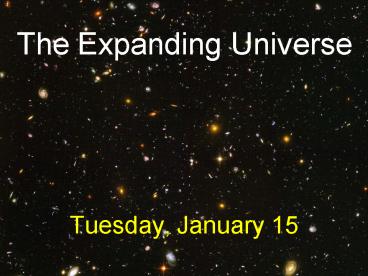The Expanding Universe - PowerPoint PPT Presentation
Title:
The Expanding Universe
Description:
Infinite universe: hard to reconcile with appearance of the night sky. Night sky is dark, with stars (small in angular size) scattered across it. ... – PowerPoint PPT presentation
Number of Views:63
Avg rating:3.0/5.0
Title: The Expanding Universe
1
The Expanding Universe
- Tuesday, January 15
2
Thomas Digges (16th century) proposed an infinite
universe.
3
Infinite universe hard to reconcile with
appearance of the night sky.
Night sky is dark, with stars (small in angular
size) scattered across it.
4
The night sky is dark called Olbers
paradox, after astronomer who discussed the
subject in 1823.
Why is the darkness of the night sky paradoxical?
5
If stars were stuck on a celestial sphere or
dome, darkness would not be paradoxical.
Only a finite number of stars on the celestial
sphere.
6
In an infinite universe with infinite number of
stars, paradox arises.
How bright do we expect the sky to be in such a
universe?
7
ASSUMPTIONS
Suppose there are n stars per cubic parsec of the
universe.
In Suns neighborhood, n 1/pc3
Suppose that an average star is a sphere with
radius R.
For Sun, R 7105 km 210-8 pc
8
(No Transcript)
9
Whats the surface area of the spherical shell?
Area 4 p r2
Whats the volume of the spherical shell?
Volume area thickness 4 p r2 t
How many stars are in the shell?
Number volume n 4 p r2 t n
10
Whats the cross-sectional area of a single star?
Cross-section p R2
Whats the cross-sectional area of all the
shells stars?
Total (p R2) (4 p r2 t n)
What fraction of the shells area is covered by
stars?
11
What fraction of the shells area is covered by
stars?
Fraction area of stars / area of shell (p R2
) ( 4 p r2 t n ) / ( 4 p r2 ) p R2 t n
Independent of r, the radius of the shell!
12
A single shell will cover only a tiny part of the
sky with stars.
For a shell 1 parsec thick, fraction
covered p R2 t n 10-15
But weve assumed an infinite number of shells!
13
1015 (one quadrillion) shells, each covering a
quadrillionth of the sky with stars,
will completely pave the sky with stars.
The entire night sky should be as bright as the
Suns surface!
14
Olbers Paradox for Trees
In a large enough forest, every line of sight
ends at a tree.
15
My conclusion that the sky is uniformly bright
is utter rubbish.
The night sky really is dark.
Which of my assumptions was wrong?
16
Dubious assumption 1
The universe is infinitely large.
Dubious assumption 2
The universe is eternally old.
17
The speed of light (c) is large but finite. c
300,000 km/sec (186,000 miles/sec).
18
If the universe has a finite age,
then distant stars havent had time to send us
the message Were here!
19
Discussing Olbers paradox, we
assumed the universe was static (neither
expanding nor contracting).
This was the general assumption until the 20th
century but was it correct?
20
If the universe is expanding, distant galaxies
will be moving away from us.
If the universe is contracting, distant galaxies
will be moving toward us.
21
Q How can we tell if a galaxy is moving toward
us or away from us?
A Look for the Doppler shift of light from the
galaxy.
22
We can think of light as a wave traveling through
space.
Wave any periodic fluctuation traveling through
a medium.
23
Ocean wave fluctuation in height of water.
Sound wave fluctuation in pressure.
Electromagnetic wave fluctuation in electric
and magnetic fields.
24
Describing a wave
25
The color of visible light is determined by its
wavelength.
Visible light wavelengths from 400 to 700
nanometers. 1 nanometer (nm)
10-9 meters
26
The Suns spectrum (amount of light as a function
of wavelength)
Note the dark lines from elements that absorb
light at specific wavelengths.
27
Radial velocity of an object is found from the
Doppler shift of its light.
Radial velocity how fast object is moving
toward you or away from you.
28
Doppler shift If a wave source moves
toward you or away from you, the wavelength
changes.
Christian Doppler (1803-1853)
29
The reason for Doppler shifts
Wave crests are bunched up ahead of wave
source, stretched out behind wave source.
30
If light source is moving toward you, wavelength
is shorter (called blueshift).
If light source is moving away from you,
wavelength is longer (called redshift).
31
Doppler shifts are easily detected in a spectrum
with dark lines.
32
In early 20th century, astronomers were surprised
to discover that all distant galaxies are
redshifted!
Galaxies moving away from each other!
33
The Universe is expanding.
Note Applies only on large scales. The Solar
System is not expanding its held
together by gravity. Milky Way Galaxy is not
expanding its held together by gravity.
34
Thursdays Lecture
The Big Bang Model
Reading
Chapter 3































